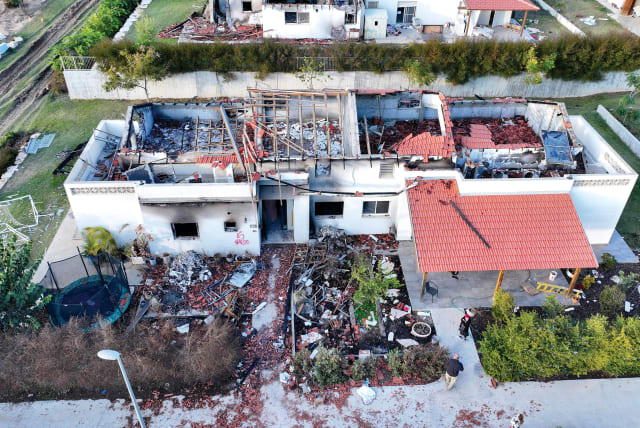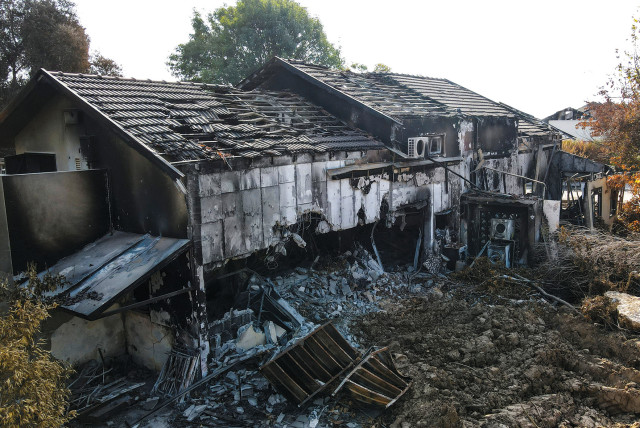How to give Israel a green future after the war with Hamas is over

Why southern Israel must tackle environmental hazards and fuel innovation in the wake of the Gaza conflict.
The aftermath of the October 7 Hamas massacre and the subsequent war have inflicted not only physical and emotional harm on the people of Israel. According to experts, it has also significantly impacted the overall environment in southern Israel.
For residents to return to their communities, it’s not only crucial for the Israel Defense Forces to neutralize the threat from Hamas and ensure the people’s security, but the Environmental Protection Ministry and its partners must also engage in the rehabilitation of severe hazards in the affected areas, said Amir Zalzberg, head of the Southern District for the Ministry of Environmental Protection.
“We have to make sure it is safe to return from the environmental perspective,” he said.
As part of a new Green South plan, the ministry recently announced that it would initiate a NIS 1 million survey of the severe hazards within the most brutally hit settlements to track the damage and ensure safe repair before residents arrive.
How did Hamas's October 7 massacre create environmental hazards in Israel's South?
The dangers were already identified in places like Kissufim, Kibbutz Magen, and Ein HaShlosha, where asbestos roofs that had been hit were replaced. Furthermore, according to Zalzberg, the ministry is proactively replacing asbestos roofs in numerous instances, even if they haven’t sustained damage, due to their potential risk of future damage.
When it comes to the air and the soil, in some cases hazardous materials were spilled, causing dangerous toxicity. For example, in Kibbutz Nir Oz, the Nirlat paint factory was burned down, releasing large quantities of solvent into the ground and the air.
According to the US Occupational Safety and Health Administration (OSHA), the active ingredients in these solvents can damage the respiratory tract, nervous system, and internal organs after exposure to large quantities or over long periods.
Moreover, since the war started, the IDF, with its cars, tanks, and Hammers, has destroyed large agricultural areas by compacting the soil, which can cause issues with its productivity, explained Prof. Amit Gross, director of the Zuckerberg Institute for Water Research at the Jacob Blaustein Institutes for Desert Research at the Sde Boker Campus of the Ben-Gurion University of the Negev.
Hamas further targeted and demolished livestock sheds and agricultural storage facilities, leading to the release of additional pollutants such as manure, gasoline, and sewage into the air, he said.
The animal carcasses themselves left an environmental hazard, noted Zalzberg. For example, in Yad Mordechai, the terrorists burned a chicken coop, causing thousands of chickens to die. The birds were buried in place, Zalzberg said, because they could not be removed at the start of the security situation.
In other communities, larger animals, such as cows, suffered fatalities in their sheds or experienced illness, exacerbated by the inability to be appropriately tended, milked, or fed. Those that did manage to survive October 7 could not be adequately cleaned, leading to the accumulation of organic waste.
“The worst was the bodies of the [slain] terrorists that stayed a long time in place,” Zalzberg added, causing a sanitation crisis. IDF soldiers stationed in the South have complained about flies and mosquitoes, which can be pesky and dangerous.
The Environmental Protection Ministry highlighted that some insects may cause diseases and damage the environment. The ministry said mosquitoes can bite and transmit diseases such as West Nile fever. Sandflies can bite and transmit Leishmaniasis of the skin. House and flesh flies can transmit intestinal diseases due to contamination of exposed food.
Gross said that it would take an estimated three years to fully rejuvenate the South’s soil and recover the lost agricultural capacity.
However, he said rebuilding is also an opportunity for more innovative and sustainable agriculture. This could include rolling out smart irrigation and fertilizer systems that save water and chemicals. It could also mean smarter cow sheds or other facilities.
“I think we can use more robotics, more AI,” Gross said. “If we have the funding, this can be an opportunity to do something better on the ruins.”
This is undoubtedly the hope of the Environmental Protection Ministry, which revealed a Green South plan to rebuild and rehabilitate the Negev region sustainably last month. The plan was formulated under the direction of Environmental Protection Minister Idit Silman in collaboration with the heads of local authorities.
The integral elements of the comprehensive, long-term plan, estimated to require hundreds of millions of shekels, encompass strategically minimizing landfill waste, promoting environmental planning, enhancing construction practices, and preserving open spaces. A budget of NIS 84 million has already been allocated for the first phase. The initiative, which incorporates the survey highlighted by Zalzberg, is commencing immediately and is anticipated to take at least five years to complete.
The Green South plan “will lead this beautiful land to recovery and renewal,” Silman said.
Nevertheless, there are dissenting voices regarding the suitability of the plan for the future of the South. In an article for the Hebrew website Ynet, Prof. Adi Wolfson, an authority on sustainability and professor of chemical engineering at Sami Shamoon College, expressed his skepticism. He said the Green South plan “lacks a vision for real change in the future, and it is still tied to the same old concept.”
“The environmental movement in Israel, comprising over 130 organizations and associations, must take action and unite forces to advance a significant and sustainable environmental plan for building environmental resilience in the Western Negev,” Wolfson wrote. “The plan should include anchors and goals, deficiencies and gaps, timelines and budgets, prioritizing issues while considering cost-effectiveness. It must be science-based and connected to the field, nature, and people.”
There is an additional challenge: Someone needs to rebuild and recover Gaza after the war.
“As long as there is no life in Gaza, the southern part of Israel will still be in danger,” warned Hagai Levine, chairman of the Public Health Physicians Association. “Sewage, pollution into the sea and air, rabies, zoonotic diseases – it will not be a healthy place, and people will not want to live there.
“You need good health in Gaza to promote good health in southern Israel.”
Itay Fischhendler, a professor of geography at the Hebrew University of Jerusalem and expert in trans-boundary water and energy governance, expressed similar sentiments.
“We always think we can do everything ourselves without partners because of the situation with our neighbors,” he said. “We will deal with the sewage alone. We will be energy-independent without our neighbors. We will deal with Israeli ecology.
“We can build a wall to the sky, but the water and air pollution will still come through and around it. The environment knows no political boundaries.”
Fischhendler said that when the Gazans suffer from food, energy, and water insecurity, it spills over into Israel. For example, when Israel closes off the electricity in Gaza, its wastewater facilities stop working. As a result, the wastewater gets into the sea, and the waves carry sewage from Gaza to Ashkelon, clogging up Israel’s desalination plant and putting the country’s water supply at risk.
He said that the Ashkelon desalination plant has had to be shut down many times since the start of the war.
“We want good quality air, but air pollution comes from Gaza and Egypt,” Fischhendler continued. “If you have diseases in Gaza, they will come to Israel, too.”
He pointed out that this dynamic can also function in reverse. For instance, during the “balloon intifada,” when terrorists were igniting Israeli fields by dispatching balloons affixed with explosive devices over the border, the resultant fires devastated agriculture and nature parks in Israel. At the same time, the pollution stemming from these fires traveled back to Gaza.
“We must take the environment out of the conflict,” Fischhendler said. “A healthy environment requires interdependence.”
To turn rebuilding the periphery into an opportunity, Levine said the country needs to work with the residents and consider the social, economic, geopolitical, and environmental aspects.
“There is a slogan of ‘building back better,’” he said. “The Jewish community is like a field. Even if a field is burned and one seed could grow again, there would be an entire field.
“This is a family motto and a spirit that I believe can work for the community of southern Israel.” ■
The Environment and Climate Change portal is produced in cooperation with the Goldman Sonnenfeldt School of Sustainability and Climate Change at Ben-Gurion University of the Negev. The Jerusalem Post maintains all editorial decisions related to the content.
Jerusalem Post Store
`; document.getElementById("linkPremium").innerHTML = cont; var divWithLink = document.getElementById("premium-link"); if (divWithLink !== null && divWithLink !== 'undefined') { divWithLink.style.border = "solid 1px #cb0f3e"; divWithLink.style.textAlign = "center"; divWithLink.style.marginBottom = "15px"; divWithLink.style.marginTop = "15px"; divWithLink.style.width = "100%"; divWithLink.style.backgroundColor = "#122952"; divWithLink.style.color = "#ffffff"; divWithLink.style.lineHeight = "1.5"; } } (function (v, i) { });

